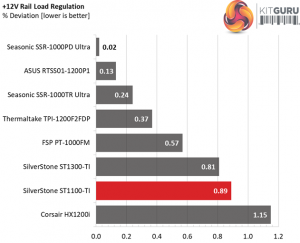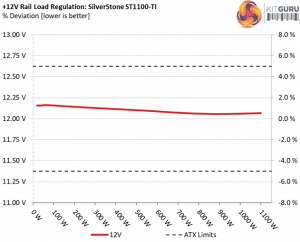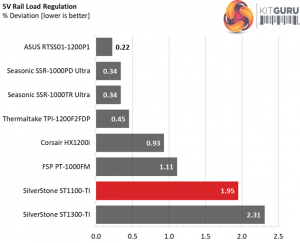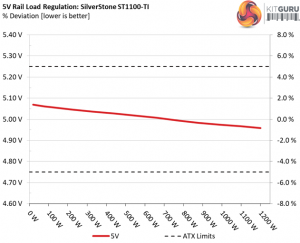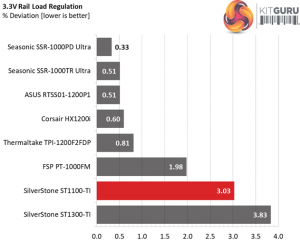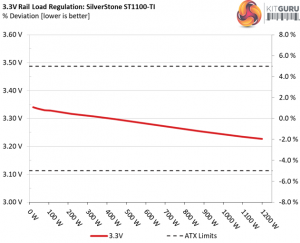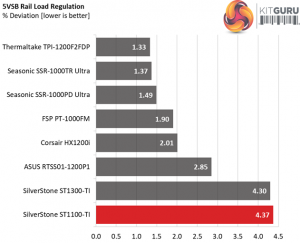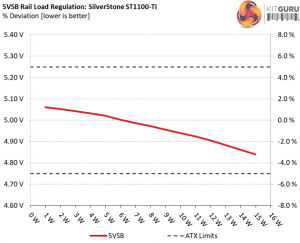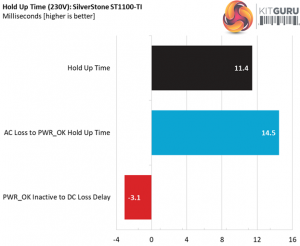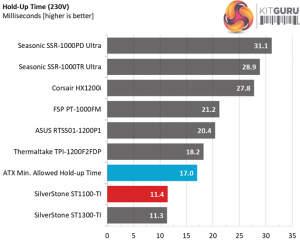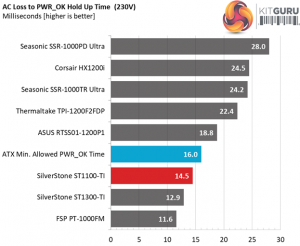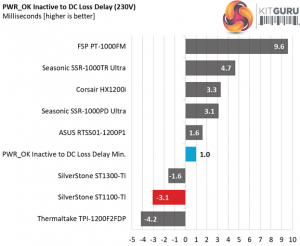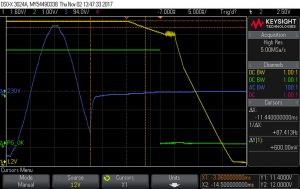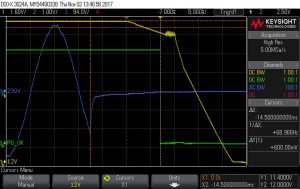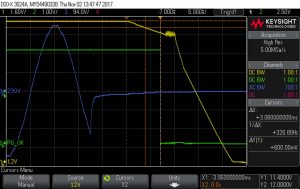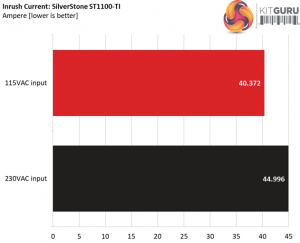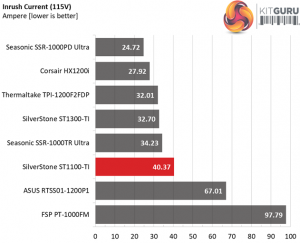To learn more about our PSU tests and methodology, please check out How We Test Power Supply Units.
Primary Rails And 5VSB Load Regulation
Load Regulation testing is detailed here.
Hold-Up Time
Our hold-up time tests are described in detail here.
The oscilloscope screenshots that we took during the hold-up time measurements:
The hold-up time is much lower than 17ms and to make matters even worse, the power ok signal is inaccurate. We don't want to see a “fake” power ok signal in any PSU, especially a high-end one. SilverStone should coordinate with Enhance Electronics and fix this problem – the sooner the better.
Inrush Current
For details on our inrush current testing, please click here.
The inrush current is at normal levels, given the platform's capacity, with both voltage inputs,
Load Regulation And Efficiency Measurements
The first set of tests reveals the stability of the voltage rails and the ST1100-TI’s efficiency. The applied load equals (approximately) 10 to 110 percent of the power supplies maximum load in increments of 10 percentage points.
We conducted two additional tests. During the first, we stressed the two minor rails (5V and 3.3V) with a high load, while the load at +12V was only 0.1A. This test reveals whether a power supply is compatible with Intel’s C6/C7 sleep states or not. In the second test, we determined the maximum load the +12V rail could handle with minimal load on the minor rails.
| Test # | 12V | 5V | 3.3V | 5VSB | DC/AC (Watts) | Efficiency | Fan Speed (RPM) | PSU Noise (dB[A]) | Temps (In/Out) | PF/AC Volts |
| 1 | 7.258A | 1.975A | 1.980A | 0.996A | 109.808 | 91.080% | 0 | <6.0 | 41.94°C | 0.946 |
| 12.156V | 5.058V | 3.328V | 5.021V | 120.562 | 38.41°C | 115.05V | ||||
| 2 | 15.551A | 2.971A | 2.985A | 1.196A | 219.649 | 93.170% | 980 | 27.9 | 38.45°C | 0.975 |
| 12.139V | 5.047V | 3.316V | 5.002V | 235.750 | 42.15°C | 115.07V | ||||
| 3 | 24.225A | 3.476A | 3.505A | 1.401A | 329.790 | 93.798% | 980 | 27.9 | 38.58°C | 0.983 |
| 12.124V | 5.036V | 3.308V | 4.987V | 351.595 | 42.45°C | 115.07V | ||||
| 4 | 32.900A | 3.975A | 4.001A | 1.606A | 439.553 | 93.660% | 980 | 27.9 | 39.16°C | 0.988 |
| 12.109V | 5.028V | 3.298V | 4.972V | 469.308 | 43.42°C | 115.08V | ||||
| 5 | 41.264A | 4.983A | 5.017A | 1.815A | 549.537 | 93.264% | 1074 | 30.5 | 39.54°C | 0.990 |
| 12.094V | 5.018V | 3.287V | 4.956V | 589.226 | 44.29°C | 115.08V | ||||
| 6 | 49.653A | 5.993A | 6.040A | 2.020A | 659.481 | 91.735% | 2040 | 45.8 | 40.36°C | 0.992 |
| 12.078V | 5.007V | 3.276V | 4.940V | 718.894 | 45.52°C | 115.09V | ||||
| 7 | 58.048A | 7.012A | 7.073A | 2.231A | 769.387 | 91.252% | 2240 | 48.7 | 41.40°C | 0.992 |
| 12.064V | 4.994V | 3.265V | 4.924V | 843.146 | 47.16°C | 115.08V | ||||
| 8 | 66.429A | 8.030A | 8.112A | 2.445A | 879.271 | 90.933% | 2275 | 49.0 | 42.37°C | 0.992 |
| 12.056V | 4.983V | 3.254V | 4.905V | 966.943 | 48.60°C | 115.09V | ||||
| 9 | 75.199A | 8.546A | 8.656A | 2.446A | 989.321 | 90.486% | 2283 | 49.1 | 44.00°C | 0.991 |
| 12.058V | 4.974V | 3.244V | 4.899V | 1093.344 | 50.73°C | 115.08V | ||||
| 10 | 83.659A | 9.065A | 9.177A | 3.094A | 1099.202 | 90.046% | 2283 | 49.1 | 45.58°C | 0.993 |
| 12.067V | 4.967V | 3.235V | 4.840V | 1220.714 | 52.61°C | 115.13V | ||||
| 11 | 95.192A | 9.076A | 9.199A | 3.091A | 1199.326 | 88.725% | 2250 | 48.8 | 47.77°C | 0.993 |
| 11.657V | 4.958V | 3.227V | 4.849V | 1351.729 | 54.99°C | 115.16V | ||||
| CL1 | 0.099A | 14.027A | 14.004A | 0.004A | 117.222 | 84.099% | 2275 | 49.0 | 44.47°C | 0.957 |
| 12.157V | 5.002V | 3.273V | 5.060V | 139.386 | 48.69°C | 115.10V | ||||
| CL2 | 91.596A | 1.004A | 1.002A | 1.002A | 1120.768 | 90.348% | 2283 | 49.1 | 47.07°C | 0.993 |
| 12.091V | 5.005V | 3.276V | 4.963V | 1240.499 | 52.14°C | 115.17V |
With 110% load, where we push the power supply beyond its official limits, the +12V rail's load regulation gets ugly. The huge voltage drop is a clear indication that 95.2A of current on this rail is way too much. Although we exceed the platform's capabilities, as we already stated, we still expected it to easily handle a 110% overload, like the majority of similar capacity units.
If you don't exceed its max current output, the +12V rail offers tight enough load regulation, while the minor rails fail to impress since several of the competing offerings perform better. Obviously, Enhance Electronics in its effort to achieve the highest possible efficiency, didn't pay much attention on the performance of the minor rails. Speaking of efficiency, the unit manages to meet three out of the four 80 PLUS Titanium requirements, even at the very high ambient temperature that we apply.
Up to the fifth load test the fan spins at low speeds, offering silent operation. During test #6 the cooling fan suddenly gets crazy and doubles its speed with the acoustics noise reaching 46 dB(A), which is very loud. But it gets even louder at higher loads, at close to 49 db(A). We don't expect a 1.1kW power supply to be whisper quiet, but we don't want to encounter such high noise output either, once it comes under high load.
 KitGuru KitGuru.net – Tech News | Hardware News | Hardware Reviews | IOS | Mobile | Gaming | Graphics Cards
KitGuru KitGuru.net – Tech News | Hardware News | Hardware Reviews | IOS | Mobile | Gaming | Graphics Cards


